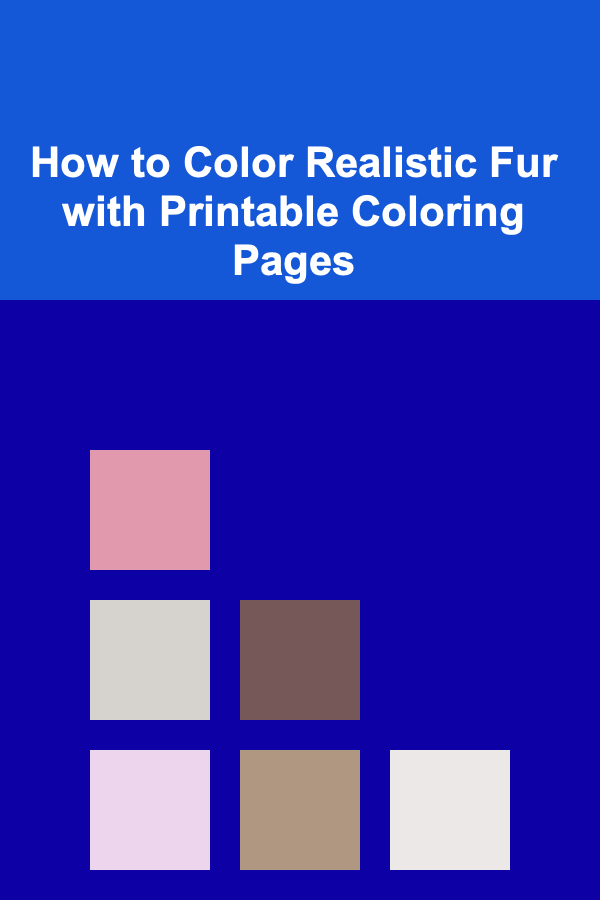
How to Color Realistic Fur with Printable Coloring Pages
ebook include PDF & Audio bundle (Micro Guide)
$12.99$6.99
Limited Time Offer! Order within the next:

Coloring can be an incredibly therapeutic activity that encourages creativity and attention to detail. For those who enjoy the process of bringing life to drawings, coloring realistic fur can be both a challenging and rewarding experience. Whether you're coloring a lion's mane, a fluffy rabbit's coat, or the sleek fur of a wolf, mastering the technique of creating realistic fur can elevate your art and bring it to life in ways that make it feel tangible.
In this article, we'll guide you through the steps and techniques for coloring realistic fur using printable coloring pages. You'll learn how to select the right colors, create texture, and add depth to your fur drawings, ensuring that they look as lifelike as possible.
Understanding Fur Texture
Before diving into the coloring process, it's essential to understand what makes fur look realistic. Fur has a distinct texture, and this texture varies depending on the type of animal. For example:
- Short Fur: Found in animals like cats and some dogs. It's smooth and sleek, often requiring more subtle shading.
- Long Fur: Seen in animals like horses, lions, and wolves. It often requires longer strokes and more intricate shading to convey depth.
- Fluffy Fur: Seen in rabbits and some long-haired breeds of dogs. Fluffy fur typically requires light, feathery strokes to simulate the softness and voluminous nature of the coat.
Understanding these differences will help you decide on the best approach for your specific drawing.
Choose the Right Coloring Tools
To achieve a realistic fur effect, the choice of coloring tools plays a significant role. Here's a breakdown of the best options:
- Colored Pencils: These are one of the most versatile tools for coloring fur. They allow for precise control over layering and texture. The fine tips of colored pencils enable you to create short, delicate strokes that mimic individual fur strands.
- Markers: While markers are excellent for vibrant, flat color, they may not be ideal for fur. If you choose markers, they can be used as a base layer for larger areas, but you'll likely need colored pencils or other tools for detailing.
- Watercolor Pencils: These offer a blend of the softness of colored pencils and the smoothness of watercolors. They can be used to add a fluid background or to create soft gradients in fur texture.
- Blending Stumps: These tools help to smooth out pencil strokes and create a more seamless look between colors, which is essential when working on fur.
Choosing high-quality materials will make the coloring process easier and help you achieve a more realistic effect.
Select the Right Colors
The next step is choosing the colors that will best represent the fur you're coloring. When working with realistic fur, it's essential to pay attention to both the base fur color and the highlights and shadows.
- Base Fur Colors: Start with the main color of the fur. Look at your reference image closely to pick out subtle tones that make up the majority of the fur. For instance, a brown bear might have a mix of light and dark browns, while a cat might have a soft grey base with hints of other colors.
- Highlight Colors: Fur reflects light, so you'll want to add lighter tones in areas where light naturally hits. These highlights typically appear along the top of the head, the back, or the top of the legs.
- Shadow Colors: Use darker shades to create shadows. Fur naturally has depth, and shadows add dimension to the drawing. Use darker shades of the base color or even a complementary color to add shadows in areas like under the chin, around the ears, or between the legs.
For example, a fox might have an orange base color, but its fur can also have shades of white on the belly, black on the paws, and even darker tones near the tail.
Layering Colors for Depth
One of the secrets to creating realistic fur is layering. Layering involves building up colors gradually rather than coloring everything in a single pass. This technique adds depth, richness, and dimension to your fur drawing.
Here's how to do it:
- Start Light: Begin by applying a light layer of your base color using gentle strokes. Make sure the strokes are in the direction of the fur growth to maintain the natural texture.
- Build Up Layers: Gradually add darker tones to the shaded areas, and build up lighter tones in the highlighted areas. Use very light pressure when layering so that the pencil doesn't press too hard onto the paper.
- Blend the Layers: Use a blending stump or a colorless blender pencil to gently blend the colors together. This will soften the transition between light and dark areas, making the fur appear smooth and natural.
- Refine Details: Once the base layers are laid down, go back with a sharper pencil to add fine details like individual fur strands. Use short, flicking motions to mimic the texture of the fur.
Creating Fur Texture with Directional Strokes
The direction of your pencil strokes is critical when coloring fur. Each stroke should mimic the natural growth direction of the fur to ensure that it looks realistic. Here's a guide for different fur types:
- Short Fur: Use quick, short strokes that follow the contours of the body. The strokes should be close together to give the fur a smooth appearance.
- Long Fur: Use longer strokes that follow the flow of the animal's body. For example, fur on a dog's back may flow in long, slightly curved lines, while fur on a cat's tail may be more pointed and feathery.
- Fluffy Fur: For animals with fluffy coats, use light, soft strokes that overlap slightly. You can build up texture in layers by layering the strokes in different directions.
When working with fur, it's crucial not to make the strokes too uniform or even. Nature is imperfect, and fur has irregularities, so adding variety to the length and direction of your strokes will enhance the realism.
Use Highlights and Shadows to Add Volume
Shadows and highlights are essential for giving fur a three-dimensional appearance. Without them, your fur will look flat and lack depth. To add volume, follow these tips:
- Add Highlights: Use an eraser to gently lift the pencil in the areas that should catch light. This is particularly useful on the top of the fur, where light would naturally reflect. You can also use a white pencil or gel pen to add highlights in areas of the fur that appear shinier.
- Deepen Shadows: For deeper shadows, you can layer a darker color, such as a charcoal gray or dark brown, over the base color. Focus on areas where the fur might overlap or fold, such as under the chin or around the legs.
By layering highlights and shadows, you'll create a more dynamic and realistic fur texture.
Adding Fine Details
Once you've laid down the base layers and added highlights and shadows, it's time to add the finer details that bring the fur to life. This is where the magic happens.
- Fine Strands of Fur: Using a sharp pencil, add individual strands of fur to areas where the fur is particularly thin or where there are significant contrasts in light and dark. Focus on areas like the muzzle, ears, and paws.
- Use a White Gel Pen: A white gel pen can be used to add highlights or to create the appearance of stray fur strands. This works particularly well on darker animals, where the contrast is noticeable.
Tip: Be patient! Realistic fur requires time, so take it slow and gradually build up the details. It's the little touches that will make your fur stand out.
Working with Printable Coloring Pages
If you're working with printable coloring pages, you have the advantage of starting with a well-structured outline. To ensure the fur looks as realistic as possible, follow these additional steps:
- Lightly Sketch Fur Texture: Before you start coloring, use a light pencil to sketch where the fur should flow. This will help you guide your strokes and ensure they follow the natural pattern.
- Test Your Colors: Test the colors on a scrap piece of paper to make sure they match the animal's natural fur color. You can mix colors to get the perfect shade.
By following the steps outlined in this article, you'll be able to color realistic fur on any animal drawing, from cats to horses to tigers. Through layering, attention to detail, and patience, you can create beautiful fur textures that look lifelike and full of depth.
Reading More From Our Other Websites
- [Personal Finance Management 101] How to Master Saving Money on Groceries While Still Eating Healthy and Delicious Meals
- [Organization Tip 101] How to Use Apps for Streamlined Home Inventory Tracking
- [Soap Making Tip 101] Best Cold‑Process Soap Formulas Using Vintage Essential Oils
- [Personal Care Tips 101] How to Choose a Shampoo with Moisturizing Properties
- [Sewing Tip 101] Best Tips for Sewing Intricate Embroidered Floral Motifs by Hand
- [Home Holiday Decoration 101] How to Use DIY Decorations to Personalize Your Holiday Home
- [Beachcombing Tip 101] Eco-Friendly Beachcombing: Collecting Shark Teeth Without Harming the Habitat
- [Paragliding Tip 101] Safety First: Common Wing Damage and the Best Repair Strategies for Every Situation
- [Personal Finance Management 101] How to Navigate Tax Season and Maximize Your Refund
- [Home Rental Property 101] How to Enhance Curb Appeal for Your Rental Property

How to Choose the Best Soundproofing Foam for Your Needs
Read More
How to Install Soundproofing Materials in Your Home
Read More
How to Organize Your Home Office for Seasonal Productivity
Read More
Selecting the Best Pastry Wheel for Lattice Tops
Read More
How to Ace Your Nurse Practitioner Clinical Skills Exam
Read More
10 Common Petty Cash Reimbursement Mistakes (and How to Avoid Them)
Read MoreOther Products

How to Choose the Best Soundproofing Foam for Your Needs
Read More
How to Install Soundproofing Materials in Your Home
Read More
How to Organize Your Home Office for Seasonal Productivity
Read More
Selecting the Best Pastry Wheel for Lattice Tops
Read More
How to Ace Your Nurse Practitioner Clinical Skills Exam
Read More